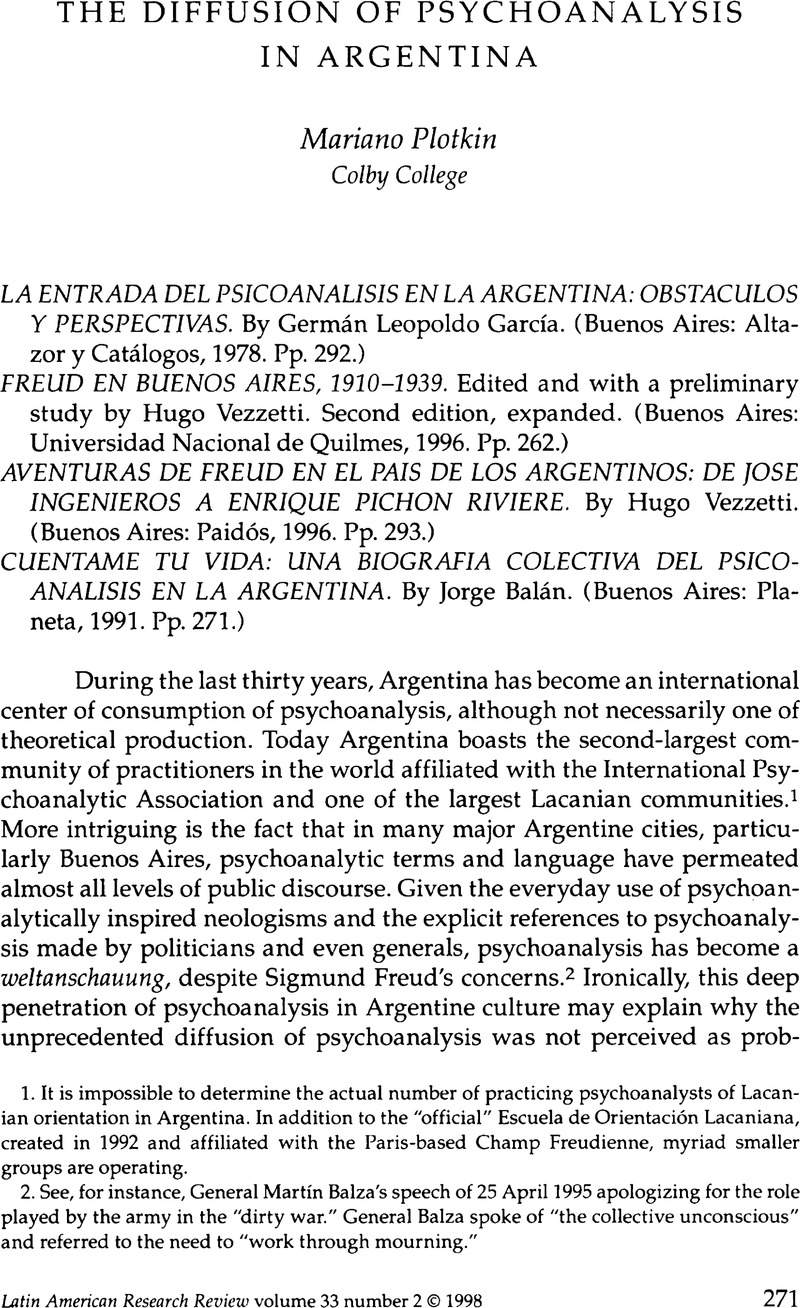Article contents
The Diffusion of Psychoanalysis in Argentina
Review products
Published online by Cambridge University Press: 05 October 2022
Abstract

- Type
- Review Essays
- Information
- Copyright
- Copyright © 1998 by the University of Texas Press
References
Notes
1. It is impossible to determine the actual number of practicing psychoanalysts of Lacanian orientation in Argentina. In addition to the “official” Escuela de Orientación Lacaniana, created in 1992 and affiliated with the Paris-based Champ Freudienne, myriad smaller groups are operating.
2. See, for instance, General Martín Balza's speech of 25 April 1995 apologizing for the role played by the army in the “dirty war.” General Balza spoke of “the collective unconscious” and referred to the need to “work through mourning.”
3. In addition to the books reviewed here, see also Silvia Inés Fendrik, Desventuras del psicoanálisis: Donald Winnicott, Arminda Aberastury, Telma Reca (Buenos Aires: Ariel, 1993); Mariano Plotkin, “Freud, Politics, and the Porteños: The Reception of Psychoanalysis in Buenos Aires, 1910–1943,” Hispanic American Historical Review 77, no. 1 (Feb. 1997):45-74; and Plotkin, “Freud en la Universidad de Buenos Aires: La primera etapa hasta la creación de la carrera de psicología,” Estudios Interdisciplinarios de América Latina y el Caribe 7, no. 1 (Jan.–July 1996):23–40 (published in Tel Aviv). Recently, Emilio Rodrigué, a prestigious Argentine psychoanalyst residing in Brazil, published the first major biography of Freud written by a Latin American. See Rodrigué, Sigmund Freud: El siglo del psicoanálisis, 2 vols. (Buenos Aires: Sudamericana, 1996).
4. Thomas Glick, “The Reception of Psychoanalysis in France: Lacan and Company,” Intellectual History Newsletter 13 (1991):63–67.
5. Sigmund Freud, On The History of the Psychoanalytic Movement, vol. 14 of The Standard Edition of the Complete Psychological Works of Sigmund Freud, edited by James Strachey (London: Hogart, 1981), first published in 1953; and Ernest Jones, The Life and Work of Sigmund Freud, 3 vols. (New York: Basic Books, 1953).
6. Arminda Aberastury, Marcelo Aberastury, and Fidias Cesio, Historia, enseñanza y ejercicio legal del psicoanálisis (Buenos Aires: Omega, 1967); Jorge Mom, Gilda Foks, and Juan Carlos Suárez, Asociación Psicoanalítica Argentina, 1942–1982 (Buenos Aires: APA, 1982); and Asociación Psicoanalítica Argentina, Asociación Psicoanalítica Argentina, 1942–1992, coordinated by Raquel Rascovsky de Salvarezza (Buenos Aires: APA, 1993).
7. A shorter version of this book was published under the title Oscar Masotta y el psicoanálisis castellano (Buenos Aires: Puntosur, 1980).
8. By Lacanian, I refer to those who follow the psychoanalytic doctrines of Jacques Lacan, who broke with the International Psychoanalytic Association in the 1950s.
9. There are important theoretical differences between traditional and Lacanian psychoanalysis, although Lacan always claimed that what he was doing was “going back to Freud.” The main reason for Lacan's expulsion from the IPA in the 1950s was his insistence on using short sessions as opposed to the traditional fifty-minute time frame demanded by the IPA. For a thorough discussion of Lacan's theories, see Sherry Turkle, Psychoanalytic Politics: Jacques Lacan and Freud's French Revolution, 2d ed. (London: Free Association Books, 1992); and Elisabeth Roudinesco, Jacques Lacan & Co.: A History of Psychoanalysis in France, 1925–1985 (London: Free Association Books, 1990).
10. Other books written by Vezzetti on related topics are La locura en la Argentina (Buenos Aires: Folios, 1983), and El nacimiento de la psicología en la Argentina, edited and with a preliminary study by Vezzetti (Buenos Aires: Puntosur, 1988).
11. Greve's paper was cited by García. It was also mentioned by Freud in On the History of the Psychoanalytic Movement as proof of the expansion of psychoanalysis in the Spanish-speaking world.
12. Christofredo Jackob, “Problemas actuales de psiquiatría general y sus relaciones con las ciencias sociales y jurídicas,” Revista de Criminología, Psiquiatría y Medicina Legal 4 (1917):7.
13. In 1976 an APA split led to a new institution, the Asociación Psicoanalítica de Buenos Aires (APdeBA), affiliated with the new International Psychoanalytic Association.
- 1
- Cited by


